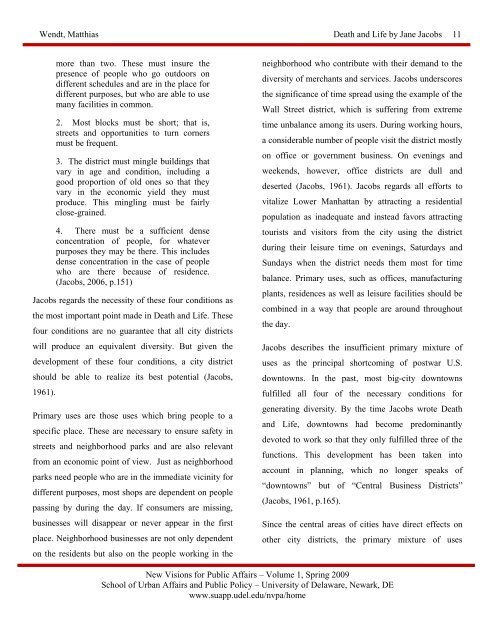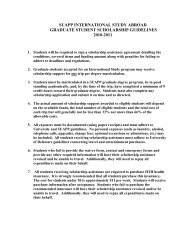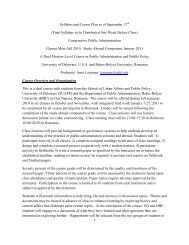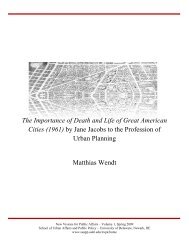New Visions for Public Affairs Volume 1 - School of Public Policy ...
New Visions for Public Affairs Volume 1 - School of Public Policy ...
New Visions for Public Affairs Volume 1 - School of Public Policy ...
Create successful ePaper yourself
Turn your PDF publications into a flip-book with our unique Google optimized e-Paper software.
Wendt, Matthias Death and Life by Jane Jacobs 11<br />
more than two. These must insure the<br />
presence <strong>of</strong> people who go outdoors on<br />
different schedules and are in the place <strong>for</strong><br />
different purposes, but who are able to use<br />
many facilities in common.<br />
2. Most blocks must be short; that is,<br />
streets and opportunities to turn corners<br />
must be frequent.<br />
3. The district must mingle buildings that<br />
vary in age and condition, including a<br />
good proportion <strong>of</strong> old ones so that they<br />
vary in the economic yield they must<br />
produce. This mingling must be fairly<br />
close-grained.<br />
4. There must be a sufficient dense<br />
concentration <strong>of</strong> people, <strong>for</strong> whatever<br />
purposes they may be there. This includes<br />
dense concentration in the case <strong>of</strong> people<br />
who are there because <strong>of</strong> residence.<br />
(Jacobs, 2006, p.151)<br />
Jacobs regards the necessity <strong>of</strong> these four conditions as<br />
the most important point made in Death and Life. These<br />
four conditions are no guarantee that all city districts<br />
will produce an equivalent diversity. But given the<br />
development <strong>of</strong> these four conditions, a city district<br />
should be able to realize its best potential (Jacobs,<br />
1961).<br />
Primary uses are those uses which bring people to a<br />
specific place. These are necessary to ensure safety in<br />
streets and neighborhood parks and are also relevant<br />
from an economic point <strong>of</strong> view. Just as neighborhood<br />
parks need people who are in the immediate vicinity <strong>for</strong><br />
different purposes, most shops are dependent on people<br />
passing by during the day. If consumers are missing,<br />
businesses will disappear or never appear in the first<br />
place. Neighborhood businesses are not only dependent<br />
on the residents but also on the people working in the<br />
neighborhood who contribute with their demand to the<br />
diversity <strong>of</strong> merchants and services. Jacobs underscores<br />
the significance <strong>of</strong> time spread using the example <strong>of</strong> the<br />
Wall Street district, which is suffering from extreme<br />
time unbalance among its users. During working hours,<br />
a considerable number <strong>of</strong> people visit the district mostly<br />
on <strong>of</strong>fice or government business. On evenings and<br />
weekends, however, <strong>of</strong>fice districts are dull and<br />
deserted (Jacobs, 1961). Jacobs regards all ef<strong>for</strong>ts to<br />
vitalize Lower Manhattan by attracting a residential<br />
population as inadequate and instead favors attracting<br />
tourists and visitors from the city using the district<br />
during their leisure time on evenings, Saturdays and<br />
Sundays when the district needs them most <strong>for</strong> time<br />
balance. Primary uses, such as <strong>of</strong>fices, manufacturing<br />
plants, residences as well as leisure facilities should be<br />
combined in a way that people are around throughout<br />
the day.<br />
Jacobs describes the insufficient primary mixture <strong>of</strong><br />
uses as the principal shortcoming <strong>of</strong> postwar U.S.<br />
downtowns. In the past, most big-city downtowns<br />
fulfilled all four <strong>of</strong> the necessary conditions <strong>for</strong><br />
generating diversity. By the time Jacobs wrote Death<br />
and Life, downtowns had become predominantly<br />
devoted to work so that they only fulfilled three <strong>of</strong> the<br />
functions. This development has been taken into<br />
account in planning, which no longer speaks <strong>of</strong><br />
“downtowns” but <strong>of</strong> “Central Business Districts”<br />
(Jacobs, 1961, p.165).<br />
Since the central areas <strong>of</strong> cities have direct effects on<br />
other city districts, the primary mixture <strong>of</strong> uses<br />
<strong>New</strong> <strong>Visions</strong> <strong>for</strong> <strong>Public</strong> <strong>Affairs</strong> – <strong>Volume</strong> 1, Spring 2009<br />
<strong>School</strong> <strong>of</strong> Urban <strong>Affairs</strong> and <strong>Public</strong> <strong>Policy</strong> – University <strong>of</strong> Delaware, <strong>New</strong>ark, DE<br />
www.suapp.udel.edu/nvpa/home







